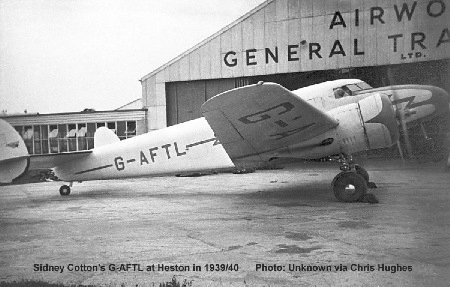One week before Hitler invaded Poland in 1939, an Australian spy posing as a businessman flew a civilian plane out of Berlin, taking aerial photographs along his way to London that documented German …
This item is available in full to subscribers.
We have recently launched a new and improved website. To continue reading, you will need to either log into your subscriber account, or purchase a new subscription.
If you had an active account on our previous website, then you have an account here. Simply reset your password to regain access to your account.
If you did not have an account on our previous website, but are a current print subscriber, click here to set up your website account.
Otherwise, click here to view your options for subscribing.
* Having trouble? Call our circulation department at 360-385-2900, or email our support.
Please log in to continue |
|

One week before Hitler invaded Poland in 1939, an Australian spy posing as a businessman flew a civilian plane out of Berlin, taking aerial photographs along his way to London that documented German troop movements for Allied Intelligence.
Today, Sidney Cotton’s Lockheed 12A Electra Junior, call sign G-AFTL, sits in pieces in Tailspin Tommy’s hangar at the Jefferson County Airport.
“Man if that plane could talk, just think of the stories it would tell,” Scott Erickson, Tailspin Tommy’s owner said. “It’s kind of like finding Amelia Earhart’s plane.”
The twin-engine all-aluminum plane has played several important roles in American culture, both as a plane and as a movie prop.
G-AFTL’s tan leather passenger seats have been removed, revealing wiring and metal struts. An oil pan catches drippings from the port side engine, where the cowling has been removed and the engine is exposed.
The silver and orange lighting-bolt-striped plane was built in 1936 in Burbank, California. In 1939 the plane was sold to Australian Sidney Cotton and shipped to England where it was re-assembled.
Under the guise of his business, photography, Cotton flew over military installations in Germany, Sicily, Cairo, Malta and Libya before the beginning of WWII, taking pictures along the way for British Intelligence MI6.
Cotton had outfitted the base of the plane with two hidden state-of-the-art retractable cameras of his own design which he could activate from the cockpit, but were undetectable in inspections. Later he installed two additional cameras in the wings which were activated by a lever under the pilot’s seat.
Cotton was known as something of a loose cannon, always looking for his next adventure. He didn’t buy his 12A originally for spying but after being approached by MI6 in 1939 he couldn’t turn down what he thought would be the adventure of a lifetime. Cotton was resourceful, always scheming, planning and designing.
For his cameras, warm cabin air was diverted to prevent condensation, a trick he had perfected in the standard-issue SidCot suits he designed for pilots that were used until the 1950s by the Royal Air Force.
Among Cotton’s friends were British Prime Minister Winston Churchill, photo magnate George Eastman of Eastman Kodak and Ian Fleming, who went on to write the James Bond series
He also invented a teardrop-shaped window for his plane, allowing him to take pictures out the port side while flying. The design was picked up and placed in thousands of aircraft but Cotton never took a royalty.
In his autobiography “Aviator Extraordinary: The Sidney Cotton Story as told to Ralph Baker,” Cotton says he offered to fly Hermann Goering, one of Adolf Hitler’s closest advisors, in the Lockheed 12A to England in 1939 before the invasion of Poland, to prevent war. He thought it possible to contact Goering through a mutual friend, but the war machine could not be stopped and Cotton fled Germany.
During the war the Lockheed flew in a squadron of spy planes commanded by Cotton, before a plot by his fellow officers to discredit him forced him to leave the military.
Lockheed would go on to design the now infamous spy plane model Lockheed U-2, which was flown by the U.S. during the Cold War.
Cotton’s plane came to Tailspin Tommy’s for what is called annual maintenance after it was purchased by three French antique collectors, who Erickson believes plan to put it in a French aero museum.
According to the records accompanying the plane, it hasn’t been worked on since 2001 and now needs repairs to the engine, landing gear and control system to be flight ready Erickson said.
“The maintenance on it has obviously been neglected for many years,” Erickson said. “So it’s turning out to be a big project and will probably be here all summer.”
After Cotton stopped flying the plane during the war, it sat at Heston Aerodrome west of London, one of England’s main airfields in WWII, before it was damaged in a German air raid. From there the plane returned to the U.S. where it was repaired and restored.
Eventually the plane was sold to aerobatic pilot Art Scholl in the 1970s. Scholl worked as a stunt flyer in film and television and flew the Lockheed in several films like “Doc Savage: The Man of Bronze,” “Freebie and the Bean” and the two-part TV mini series “Amelia Earhart.”
Many owners, exchanges and thousands of flight hours later, the 12A ended up in Washington state and, Erickson said, was sitting in a warehouse in Arlington before it was purchased and brought to Hadlock for repairs.
Cotton’s Lockheed 12A is the most unique and interesting plane to ever come through his shop, Erickson said. Outside of its history the model itself has become very rare, he said. He estimates there are less than five still flying in the U.S.